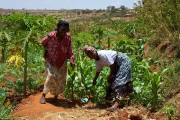The ad from Oxfam is striking. An African woman wearing a green-and-black-striped polo shirt and holding a pineapple stares intently. “Women provide 66% of the work, produce 60% of the food, but earn only 10% of the income and own 1% of the property,” the ad says. “We can do better.”
The statistics would be shocking—if they were true. But as Washington Post Fact Check columnist Glenn Kessler notes in this informative column, the statistics Oxfam cites are “too good to be true.” And the reasons why they aren’t true tell us something about how nonprofits use statistics.
I am aware that fact checkers have their ideological problems. Mark Hemingway of the Weekly Standard has done good work on the biases of fact checkers here and here. As a result, I do not believe most of the claims fact checkers make against Republican politicians.
But as far as I know, there are no Republican politicians working for Oxfam, and I would be amazed if this large nonprofit employed any Republicans. What Kessler does here is what fact checkers are supposed to do—look at claims and see if they’re true or not.
As Kessler notes, Philip N. Cohen did most of the work debunking this particular claim in 2011. Cohen, a University of Maryland sociologist and the author of an authoritative textbook on marriage and the family, notes that these particular statistics have appeared frequently over the decades, most notably in Robin Morgan’s 1984 anthology Sisterhood Is Global. Morgan claimed the source for these statistics was a 1980 United Nations Development Program report called “Women and the New International Order.” But that report cites an earlier source, a 1978 article in an International Labour Organization journal called Women at Work.
Where did Women at Work get this information? Here is the citation Cohen unearthed:
A world profile on women, using selected economic and social indicators, reveals that women constitute one-half of the world population and one third of the official labour force; perform nearly two-thirds of work hours, but according to some estimates receive only one-tenth of the world income and possess less than one-hundredth of world property.
There is no explanation for where these statistics come from, but in 2007 the editor of Women at Work, Krishna Ahooja-Patel, wrote that the data was “based on some available global data and others derives by use of fragmentary indicators at the time, in the late 1970s.” Contacted by the Post last month, she added that ”the knowledge of statistics we were looking at in that period were estimates and the national statistical offices of the period did not cover women’s issues or data.” In other words, what she offered were guesstimates, which have lasted from the 1970s to today.
Take the notion that women only have 1 percent of the world’s property, which Ahooja-Patel claimed in 2007 was because women’s wages were so low, “it can be assumed they do not normally have any surplus to invest in reproducible or non-reproducible assets.”
Philip Cohen responds that “even in 1970, how could women own only 1% of property, when most women were married and in many countries had at least some legal claim to their families’ property?”
What about income? Philip Cohen notes that American women alone produce 5 percent of the world’s income. A study issued in January by the British nonprofit ActionAid, which claims that the world’s women need a $2 trillion pay raise to earn as much as men, estimates that women earn 36 percent of the world’s income. You might argue that 36 percent is a figure that’s far too low, but 36 is a higher number than 10.
For the final two pieces of evidence, on food and property ownership, we turn to Yale economist Cheryl Doss. In a post last October for an agriculture research nonprofit known as CGIAR, Doss asks a simple question: on a farm, how do we know whether women or men are growing a crop?
How would we know if a particular kilo of maize was grown by a woman? Is it maize grown on her land? Produced with her labor? Or is it maize she takes to market to sell? If a wheat field was cleared by a man, planted and weeded by a woman, and harvested by the whole family—men, women, and children—who produced the wheat? And when women purchase bread from a shop, who produced it?
Professor Doss has also done research on what percentage of the world’s property is owned by women. (The research, ironically, appears on a blog on Oxfam’s website.) She reports that there is no global estimate as to how much property is owned by women. Doss and several colleagues, in research for the International Food Policy Research Institute, have come up with estimates for several African countries. In Senegal, for example, only 11 percent of women own property—but only 28 percent of men do, and only 47 percent of Senegalese own land.
But Senegal has property ownership rates that are unusually low, even for Africa. In the remaining number of countries surveyed, the rates of property ownership for women range from 30 percent in Tanzania to 54 percent in Rwanda and Burundi. Even in Zimbabwe, 36 percent of women and 36 percent of men own land.
Cheryl Doss, who favors Third World women owning more land, observes,
Using unsubstantiated statistics for advocacy is counterproductive. Advocates lose credibility by making claims that are inaccurate and slow down progress toward achieving their goals because without credible data, they can’t measure changes.
I’d go farther. If Oxfam is making dubious claims in their ads that are directly contradicted by reliable information found on their own website, how much should we believe other charges Oxfam makes?







In response to Oxfam, which undoubtedly included these statistics in a fundraising solicitation, the potential donor appropriately asks “What has Oxfam done in the 45 years of its existence to change these statistics?” If they can show credible evidence of contributing to the amelioration of the wrongs they highlight, then perhaps they would be worthy of supporting. However, simply making the claim of the existence of injustice should be absolutely unmoving for donors.